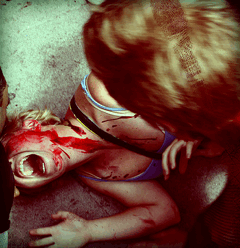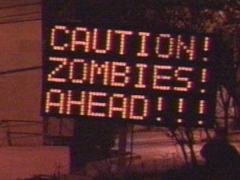DEAD-icated Scientists
Air Date: Week of October 23, 2009

If properly armed, an average human can fend off 7-8 classic, slow-moving zombies. Modern zombies move faster. (http://www.flickr.com/photos/purplemattfish/3714903911/)
In the event of a Zombie infestation, what would you do? Quarantine the zombies, try to develop a cure, or load your shotgun and aim for the head? Philip Munz, author of When Zombies Attack!: Mathematical Modeling of an Outbreak of Zombie Infection shares his findings with host Jeff Young.
Transcript
[THEME]
YOUNG: We recently came across an alarming paper in the scientific journal Infectious Disease Modeling Research Progress. A team of mathematicians from Canada modeled the potential outbreak of a new disease and found -- quoting here - "an outbreak is likely to be disastrous unless extremely aggressive tactics are employed. It’s imperative that those infected are dealt with quickly or else we are all in a great deal of trouble" – end quote. Well, that got our attention, so we called up one of the paper's authors, Philip Munz at Carleton University in Ottawa. So – Philip Munz - what exactly is this infection we are talking about?
MUNZ: Uh, sadly, this infection is a zombie outbreak.

The zombie virus is transmitted through biting. A newly infected victim may retain human characteristics during the latency period which can last between one minute and half a movie. (http://www.flickr.com/photos/captaintim/3081877028/)
[SCREAMS OF TERROR; HORROR MOVIE MUSIC]
YOUNG: Zombies, you say?
MUNZ: Zombies, yes.
[OLD MOVIE SOUNDS; SNARLING ANIMAL]
YOUNG: Okay, so this is a serious mathematical model based on a fictitious horror movie scenario– do I understand this?
MUNZ: This is some heavy math and some realistic math dealing with the fictional zombie disease.
YOUNG: First off, what kind of zombies are we talking about here because, you know, as any fan of zombie movies would know, not all zombies are the same. What zombies are yours like?
MUNZ: Oh no, yeah, you’re preaching the choir when you talk about all the different types of zombies. The zombies that we cover are the ones that you see in the 1968 movie, “Night of the Living Dead,” which was the first real pop-culture zombie flick.
[MAN SAYING “THE DEAD WHO LIVE ON LIVING FLESH”; SCREAMING VOICES; MAN SAYING “NIGHT OF THE LIVING DEAD…”]
YOUNG: [Laughs] The classical approach, if you will, to zombies.
MUNZ: Yes, the classical approach.
YOUNG: Okay, so zombie enters your town, what happens, how does the model play out?
MUNZ: So, yes, our ideas were sort of taken out of movies where, like in “Shaun of the Dead,” people don’t realize why someone attacked them and that someone actually ends up being a zombie.
[MAN SAYING “OH MY GOD, SHE’S SO DRUNK…”]
MUNZ: And then before people actually start realizing what’s happening, there’s already quite a large number of zombies around in the city.
YOUNG: Hmm, okay. What might we do about it? Could we quarantine them?

If properly armed, an average human can fend off 7-8 classic, slow-moving zombies. Modern zombies move faster. (http://www.flickr.com/photos/purplemattfish/3714903911/)
MUNZ: Well, that’s actually one of the things we look at in the paper. We thought that the quarantine would be the fastest thing that you could coordinate on such as short notice. The problem was…was that with zombies could can tell that they’re zombies, with people who are infected you can’t so much tell if they’ve been infected by a zombie if they’re not a zombie yet.
YOUNG: Ah, so there’s some latency between infection and full-blown zombieism.
MUNZ: Yes. And again, stuff that you see in movies where the boyfriend gets bit, and he’s like, oh I’m fine. But, then halfway through the movie, they’ve got the dramatic interlude where the girlfriend has to take out her boyfriend.
[SOUNDS OF HEAVING BREATHING; PHONE OPERATOR TONE; WOMAN SAYING “LOUIS, WHAT ARE YOU DOING?”; ZOMBIE SNARL]
YOUNG: Happens all the time.
MUNZ: Yeah. You know, so it’s not an instantaneous change from a human to a turning into a zombie.
YOUNG: So, if you can’t successfully quarantine every one, if just a few escape the quarantine doesn’t work, according to your model, is that right?
MUNZ: Exactly, the quarantine doesn’t work, and it’s very hard to find these people who are infected, but not yet zombies.

An early warning system would be useful in the event of outbreak. (http://www.flickr.com/photos/reana/3238910501/)
YOUNG: Okay, so quarantine is out. Doesn’t work. Scientists are hard at work to find out what this is about; they come up with a cure. Is that an option?
MUNZ: Yeah. Say the quarantine at least was a little bit helpful and they did come up with a cure – what possibilities might the cure hold? So our cure changes a zombie back to a human, pretty much right away. But, then once the person is human again, they’re susceptible to turning back into a zombie.
YOUNG: Oh, so it’s not a vaccine?
MUNZ: No, it’s not a vaccine. Even so, we thought well, let’s give it a try; let’s see what happens with the cure. And we were actually able to come up with a bit of a state where if we had enough resources, there’s only about ten percent human at any one time and the rest of the people in the city have turned into zombies.
YOUNG: That’s pretty grim; the cure is not sounding like a great option here. So, what is the ultimate solution here? I’m imagining the scene in the movie where the scientist, possibly played by Jeff Goldblum, goes to the authorities and says here’s what we have to do.
MUNZ: Uh, the assistant to Jeff Goldblum would be me, in that movie. Actually, the scientists would say the only chance we have is lethal force.
YOUNG: So, lock and load, aim for the head, that’s the ultimate recommendation here?
[Man speaking: “Yeah, okay, Chief, if I were surrounded by six or eight of these things, would I stand a chance with them?” “Well, there’s no problem, if you had a gun, shoot ‘em in the head, that’s a sure way to kill ‘em, if you don’t, get yourself a club or a torch – beat ‘em or burn ‘em, they go up pretty easy.”]
MUNZ: So, we though, okay, let’s see what we could do to model that, using math that actually gave proof to the fact that, yeah, at the end of those movies when the army comes in and takes out, wipes out, a whole bunch of zombies at a time, that’s actually a feasible solution.
YOUNG: As a mathematician, does this add to your enjoyment of zombie movies? To go to one, watch it, and say, yep, that’s the way it would happen?
MUNZ: [Laughs] I do that with pretty much all the movies, not just zombie movies. Well, could the Borg take over the human race?
YOUNG: [Laughs] What about romantic comedies? Do you apply your mathematically modeling to rom-coms?
MUNZ: Those ones actually, there is no logic, in those.
YOUNG: Good point. [Laughs] Philip Munz’s paper is called “When Zombies Attack: Mathematically Modeling of an Outbreak of Zombie Infection”. Great fun talking with you.
MUNZ: Well, thank you for having me.
YOUNG: And, you know, it sounds like you got a big brain…my advice: be careful out there.
MUNZ: [Laughs] Yeah…they want me for my brain, those zombies.
Links
Night of the Living Dead established the pop cultural understanding of flesh eaters.
Living on Earth wants to hear from you!
Living on Earth
62 Calef Highway, Suite 212
Lee, NH 03861
Telephone: 617-287-4121
E-mail: comments@loe.org
Newsletter [Click here]
Donate to Living on Earth!
Living on Earth is an independent media program and relies entirely on contributions from listeners and institutions supporting public service. Please donate now to preserve an independent environmental voice.
NewsletterLiving on Earth offers a weekly delivery of the show's rundown to your mailbox. Sign up for our newsletter today!
 Sailors For The Sea: Be the change you want to sea.
Sailors For The Sea: Be the change you want to sea.
 The Grantham Foundation for the Protection of the Environment: Committed to protecting and improving the health of the global environment.
The Grantham Foundation for the Protection of the Environment: Committed to protecting and improving the health of the global environment.
 Contribute to Living on Earth and receive, as our gift to you, an archival print of one of Mark Seth Lender's extraordinary wildlife photographs. Follow the link to see Mark's current collection of photographs.
Contribute to Living on Earth and receive, as our gift to you, an archival print of one of Mark Seth Lender's extraordinary wildlife photographs. Follow the link to see Mark's current collection of photographs.
 Buy a signed copy of Mark Seth Lender's book Smeagull the Seagull & support Living on Earth
Buy a signed copy of Mark Seth Lender's book Smeagull the Seagull & support Living on Earth

